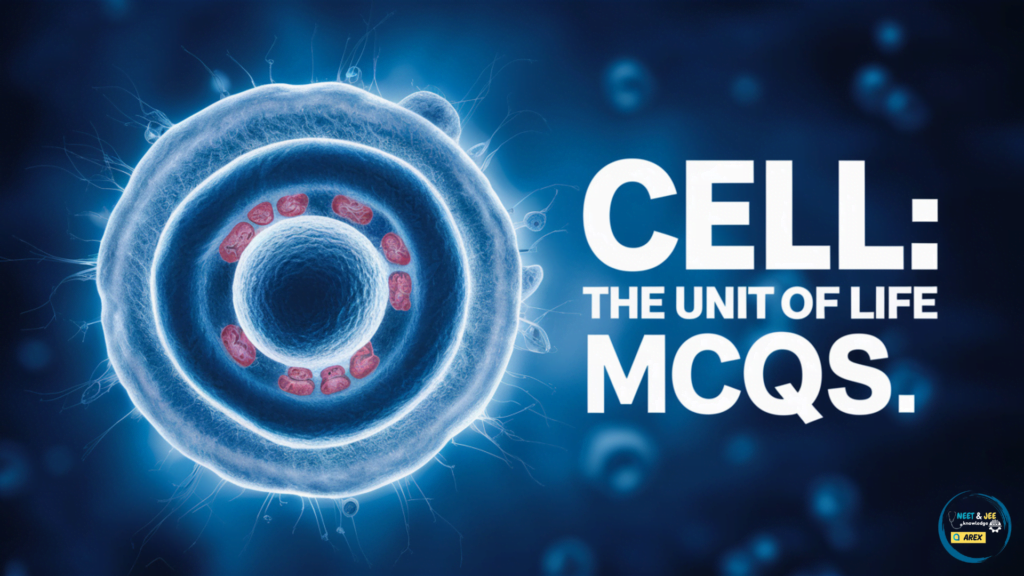
Cell: The Unit of life MCQs
The cell is the basic unit of life in all living organisms. It is the smallest structure capable of performing all the functions necessary for life. Cells come in two main types: prokaryotic and eukaryotic. Prokaryotic cells, like those of bacteria, are simpler and do not have a nucleus. Eukaryotic cells, found in plants, animals, fungi and protists, have a nucleus and other specialized structures called organelles.
| NEET 2025 Exam Important Links | |
|---|---|
| NEET 2025 Updated Syllabus | NEET Eligibility Criteria 2025 |
| Biology Preparation | Chemistry NEET Preparation |
| NEET Preparation tips for 2025 | NEET Result 2024 |
Cell: The Unit of life MCQs
Key parts of a cell include the cell membrane, which protects the cell; the cytoplasm, where chemical reactions occur and the nucleus, which contains genetic material (DNA). Other important organelles in eukaryotic cells include mitochondria (energy production), ribosomes (protein synthesis) and the endoplasmic reticulum (transportation and processing of materials).
Cells can reproduce independently, ensuring the continuation of life. Through processes like mitosis and meiosis, they divide and create new cells, essential for growth, development and repair in organisms.
MCQs
Enhance your preparation with Arexiq’s Mock Test Series where we provide solutions to various MCQs like we provide in this post “Cell The Unit Of Life MCQ”. Our expert teachers explain the concepts thoroughly, making it easy for you to understand. We offer many types of questions ensuring a clear grasp of concepts.
FAQs
1. What are the main topics covered in MCQs about “Cell: The Unit of Life”?
Answer. MCQs typically cover topics such as the structure and function of cell organelles, the differences between prokaryotic and eukaryotic cells, cell theory, the plasma membrane, cell division and various cellular processes.
2. How can I effectively prepare for MCQs on “Cell: The Unit of Life”?
Answer. To prepare effectively, study your textbook thoroughly, focus on key concepts and definitions, use diagrams to understand structures, solve previous years’ MCQs, and take regular quizzes to test your knowledge.
3. What types of questions are commonly asked in MCQs about “Cell: The Unit of Life”?
Answer. Common types of questions include identifying functions of cell organelles, differences between cell types, steps in cellular processes (like mitosis and meiosis) and understanding cell theory.
4. Are diagrams important for answering MCQs on “Cell: The Unit of Life”?
Answer. Yes, diagrams are important. Many questions may ask you to identify parts of a cell or understand processes using diagrams. Being able to interpret and label diagrams is an important skill.
5. How much detail should I know about each cell organelle for MCQs?
Answer. You should know the structure, function and importance of each cell organelle. Focus on key details that differentiate organelles and their roles in cellular processes.
6. Can MCQs about “Cell: The Unit of Life” include questions on cell division?
Answer. Yes, questions on cell division, including mitosis and meiosis, are common. Understand the phases, key events and differences between these processes.
7. What resources can I use to practice MCQs on “Cell: The Unit of Life”?
Answer. Use textbooks, online quiz platforms, NEET preparation books and previous years’ question papers. Many educational websites and apps offer practice MCQs for this topic.
8. How important is the knowledge of cell theory for MCQs?
Answer. Understanding cell theory is fundamental as it forms the basis for much of cell biology. Be familiar with the main tenets of cell theory and historical contributions to its development.
9. Will questions about differences between prokaryotic and eukaryotic cells appear in MCQs?
Answer. Yes, these differences are a common topic. Know the structural and functional differences between prokaryotic and eukaryotic cells, including examples of each.
10. How do I manage time while answering MCQs in exams?
Answer. Practice regularly to improve speed and accuracy. Read questions carefully, eliminate incorrect options first and manage your time so that you can review your answers if needed.


